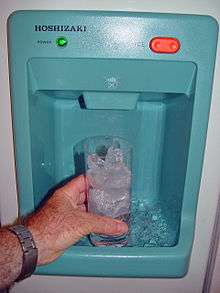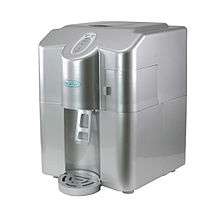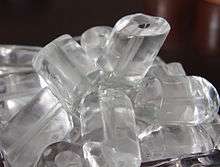Icemaker

An icemaker, ice generator, or ice machine may refer to either a consumer device for making ice, found inside a home freezer; a stand-alone appliance for making ice, or an industrial machine for making ice on a large scale. The term "ice machine" usually refers to the stand-alone appliance.
The ice generator is the part of the ice machine that actually produces the ice. This would include the evaporator and any associated drives/controls/subframe that are directly involved with making and ejecting the ice into storage. When most people refer to an ice generator, they mean this ice-making subsystem alone, minus refrigeration.
An ice machine, however, particularly if described as 'packaged', would typically be a complete machine including refrigeration, controls, and dispenser, requiring only connection to power and water supplies.
The term icemaker is more ambiguous, with some manufacturers describing their packaged ice machine as an icemaker, while others describe their generators in this way.
History
In 1748, the first known artificial refrigeration was demonstrated by William Cullen at the University of Glasgow.[1]
In 1844, an American physician, John Gorrie, built a refrigerator based on Oliver Evans' design to make ice to cool the air for his yellow fever patients.
In 1851, John Gorrie was awarded US Patent 8080 for an ice machine.
In 1853, Alexander Twining was awarded US Patent 10221 for an icemaker. In 1855, James Harrison received a similar patent for an icemaker in Australia.

In 1867, Andrew Muhl built an ice-making machine in San Antonio, Texas, to help service the expanding beef industry before moving it to Waco in 1871.[2] In 1873, the patent for this machine was contracted by the Columbus Iron Works,[3] which produced the world's first commercial icemakers. William Riley Brown served as its president and George Jasper Golden served as its superintendent. In 1902, the Teague family of Montgomery purchased control of the firm. Their last advertisement in Ice and Refrigeration appeared in March 1904.[4] In 1925, controlling interest in the Columbus Iron Works passed from the Teague family to W.C. Bradely of W.C. Bradley, Co.[4]
Principle of ice making
All refrigeration equipments are made of four key components; the evaporator, the condenser, the compressor and the throttle valve. Ice machines all work the same way. The function of compressor is to compress low-pressure refrigerant vapor to high-pressure vapor, and deliver it to the condenser. Here, the high-pressure vapor is condensed into high-pressure liquid, and drained out through the throttle valve to become low-pressure liquid. At this point, the liquid is conducted to the evaporator, where heat exchanging occurs, and ice is created. This is one complete refrigeration cycle.
Consumer icemakers
Freezer icemakers

Automatic icemakers for the home were first offered by the Servel company around 1953.[5][6] They are usually found inside the freezer compartment of a refrigerator. They produce crescent-shaped ice cubes from a metal mold. An electromechanical or electronic timer first opens a solenoid valve for a few seconds, allowing the mold to fill with water from the domestic cold water supply. The timer then closes the valve and lets the ice freeze for about 30 minutes. Then, the timer turns on a low-power electric heating element inside the mold for several seconds, to melt the ice cubes slightly so they will not stick to the mold. Finally, the timer runs a rotating arm that scoops the ice cubes out of the mold and into a bin, and the cycle repeats. If the bin fills with ice, the ice pushes up a wire arm, which shuts off the icemaker until the ice level in the bin goes down again. The user can also lift up the wire arm at any time to stop the production of ice.
Early icemakers dropped the ice into a bin in the freezer compartment; the user had to open the freezer door to obtain ice. In 1965, Frigidaire introduced icemakers that dispensed from the front of the freezer door.[7] In these models, pressing a glass against a cradle on the outside of the door runs a motor, which turns an auger in the bin and delivers ice cubes to the glass. Most dispensers can optionally route the ice through a crushing mechanism to deliver crushed ice. Some dispensers can also dispense chilled water.
Portable icemakers

Portable icemakers are units that can fit on a countertop. They are the fastest and smallest icemakers on the market. The ice produced by a portable icemaker is bullet shaped and has a cloudy, opaque appearance. The first batch of ice can be made within 10 minutes of turning the appliance on and adding water. The water is pumped into a small tub with metal pegs immersed in the water. The pegs have a heating and cooling system inside that freeze the water around them and then heat up so the ice slips off the peg and into the storage bin. Portable icemakers will not keep the ice from melting, but the appliance will recycle the water to make more ice.
Built-in and freestanding icemakers
Built-in icemakers are engineered to fit under a kitchen or bar counter, but they can be used as freestanding units. They produce crescent-shaped ice like the ice from a freezer icemaker. The ice is cloudy and opaque instead of clear, because the water is frozen faster than in clear cube icemakers. In the process, tiny air bubbles get trapped, causing the cloudy appearance of the ice.
Industrial icemakers
Commercial ice makers improve the quality of ice by using moving water. The water is run down a high nickel content stainless steel evaporator. The surface must be below freezing. Salt water requires lower temperatures to freeze and will last longer. Generally used to package seafood products. Air and undissolved solids will be washed away to such an extent that in horizontal evaporator machines the water has 98% of the solids removed, resulting in very hard, virtually pure, clear ice. In vertical evaporators the ice is softer, more so if there are actual individual cube cells. Commercial ice machines can make different sizes of ice like flakers, crushed, cube, octagon, and tube.
When the sheet of ice on the cold surface reaches the desired thickness, the sheet is slid down onto a grid of wires, where the sheet's weight causes it to be broken into the desired shapes, after which it falls into a storage bin.
Flake ice machine

Flake ice is made of the mixture of brine and water (max 500 g [18 oz] salt per ton of water), in some cases can be directly made from brine water. Thickness between 1 and 15 mm (1⁄16 and 9⁄16 in), irregular shape with diameters from 12 to 45 mm (1⁄2 to 1 3⁄4 in).
The evaporator of the flake ice machine is a vertically placed drum-shape stainless steel container, equipped with the rotating blade which spins and scratches the ice off the inner wall of the drum. When operating, the principal shaft and blade spins anti-clockwise pushed by the reducer. Water is sprayed down from the sprinkler; ice is formed from the water brine on the inner wall. The water tray at the bottom catches the cold water while deflecting Ice and re-circulates it back into the sump. The sump will typically use a float valve to fill as needed during production. Flake machines have a tendency to form an ice ring inside the bottom of the drum. Electric heaters are in wells at the very bottom to prevent this accumulation of ice where the crusher does not reach. Some machines use scrapers to assist this. This system utilizes a low temperature condensing unit; like all ice machines. Most manufactures also utilize an E.P.R.V. (Evaporator pressure regulating valve.)
Applications
Sea water flake ice machine can make ice directly from the sea water. This ice can be used in fast cooling of fish and other sea products. The fishing industry is the largest user of flake ice machines. Flake ice can lower the temperature of cleaning water and sea products, therefore it resists the growth of bacteria and keeps the seafood fresh.
Because of its large contact and less damage with refrigerated materials, it is also applied in vegetable, fruit and meat storing and transporting.
In baking, during the mixing of flour and milk, flake ice can be added to prevent the flour from self-raising.
In most cases of biosynthesis and chemosynthesis, flake ice is used to control the reaction rate and maintain the liveness. Flake ice is sanitary, clean with rapid temperature reduction effect.
Flake ice is used as the direct source of water in concrete cooling process, more than 80% in weight. Concrete will not crack if has been mixed and poured in constant and low temperature.
Flake ice is also used for artificial snowing, so it is widely applied in ski resorts and entertainment park.
Cube icemaker
Cube ice machines are classified as small ice machines, in contrast to tube ice machines, flake ice machines, or other ice machines. Common capacities range from 30 kg (66 lb) to 1,755 kg (3,869 lb). Since the emergence of cube ice machines in the 1970s, they have evolved into a diverse family of ice machines.
Cube ice machines are commonly seen as vertical modular devices. The upper part is an evaporator, and the lower part is an ice bin. The refrigerant circulates inside pipes of sale-contained evaporator, where it conducts the heat exchange with water, and freezes the water into ice cubes. When the water is thoroughly frozen into ice, it is automatically released, and falls into the ice bin.
The ice bin can also be equipped with compressors. Generally cube ice machines with over 320 kg (710 lb) capacities have built-in compressors in the ice bin for storage prior to sales, for use when demands are large.
Cube ice is created in a cubic shape, with each edge usually between 15 and 35 mm (9⁄16 and 1 3⁄8 in). The surface area of every ton of cube ice is approximately 1,383 m2 (14,890 sq ft).
Compressor
Most compressors are either positive displacement compressors or radial compressors. Positive displacement compressors are currently the most efficient type of compressor, and have the largest refrigerating effect per single unit (400–2500 RT). They have a large range of possible power supplies, and can be 380 V, 1000 V, or even higher. The principle behind positive displacement compressors utilizes a turbine to compress refrigerant into high-pressure vapor. Positive displacement compressors are of four main types: screw compressor, rolling piston compressor, reciprocating compressor, and rotary compressor.
Screw compressors can yield the largest refrigerating effect among positive displacement compressors, with their refrigerating capacity normally ranging from 50 RT to 400 RT. Screw compressors also can be divided to single-screw type and dual-screw type. Dual-screw type is more often seen in use because it is very efficient.
Rolling piston compressors and reciprocating compressors have similar refrigerating effects, and maximum refrigerating effect can reach 600 kW.
Reciprocating compressors are the most common type of compressor because the technology is mature and reliable. Their refrigerating effect ranges from 2.2 kW to 200 kW. They compress gas by utilizing a piston pushed by a crank shaft.
Rotary compressors, mainly used in air conditioning equipment, have a very low refrigerating effect, normally not exceeding 5 kW. They work by compressing gas using a piston pushed by a rotor, which spins in an isolated compartment.
Condenser
All condensers can be classified as one of three types: air cooling, water cooling, or evaporative cooling.
- An air cooling condenser uses air as the heat conducting media by blowing air through the surface of condensers, which carries heat away from the high-pressure, high-temperature refrigerant vapor.
- A water cooling condenser uses water as the heat conducting media to cooling refrigerant vapor to liquid.
- An evaporative condenser cools the refrigerant vapor by using heat exchange between the evaporator pipes and the evaporated water which is sprayed on the surface of the pipes. This type of condenser is capable of working in warm environments; they are also very efficient and reliable.
Tube ice generator

A tube ice generator is an ice generator in which the water is frozen in tubes that are extended vertically within a surrounding casing—the freezing chamber. At the bottom of the freezing chamber there is a distributor plate having apertures surrounding the tubes and attached to the separate chamber into which a warm gas is passed to heat the tubes and cause the ice rods to slide down.[8]
Applications
Tube ice can be used in cooling processes, such as temperature controlling, fish fresh freezing, and beverage bottle freezing. It can be consumed alone and with food or beverages.
See also
References
- ↑ http://inventors.about.com/library/inventors/blrefrigerator.htm The first artificial refrigeration demonstration
- ↑ "Refrigeration". tshaonline.org. Retrieved 6 April 2015.
- ↑ "(Title obscured in source)". St. Petersburg Times. June 4, 1927. Retrieved 6 April 2015.
- 1 2 Columbus Iron Works, 1853, Historic American Engineering Record, Heritage Conservation and Recreation Service, Department of the Interior
- ↑ "Ice "Cubes" Drop in Basket in Automatic Refrigerator". Popular Mechanics. 99 (2): 300. February 1953. Retrieved 30 April 2013.
- ↑ Pulos, Arthur J. (1988). The American design adventure, 1940–1975. Cambridge, Mass.: MIT Press. p. 129. ISBN 9780262161060.
- ↑ Brazeau, Mike. "The Frigidaire Story". Retrieved 4 January 2015.
- ↑ "TUBE ICE GENERATOR - STAL Refrigeration AB". freepatentsonline.com. Retrieved 6 April 2015.
External links
| Wikimedia Commons has media related to Ice machines. |
- How to Buy an Energy-Efficient Commercial Ice Machine. Federal Energy Management Program. Accessed April 2, 2009.
-
 "Ice, Artificial". Collier's New Encyclopedia. 1921.
"Ice, Artificial". Collier's New Encyclopedia. 1921.